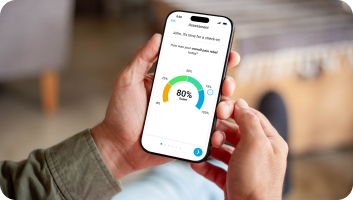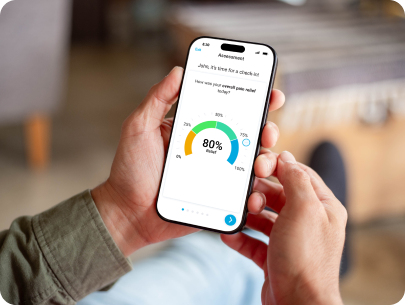STEP 1
Do you qualify?
HFX helps relieve severe burning, shooting, pins and needles pain from diabetic neuropathy.
HFX could be right for you if you meet the criteria below:
- You’ve been diagnosed with diabetic neuropathy pain in your feet or legs
- You’ve tried two or more prescription pain medications and haven’t found relief or want to avoid the side effects of medications
Answer a few questions to see if HFX could relieve your pain.

STEP 2
Connect with your HFX Coach™ to find an HFX doctor
Only an HFX doctor can determine if HFX is right for you.
After you take the short assessment, request a call from an HFX Coach. Your HFX Coach is a real person assigned to you who will answer your questions and connect you with an HFX doctor in your area.
Or if you don’t need help, you can simply search your zip code, and find an HFX doctor using the Find a Doctor search tool. You can call any of the doctors listed in your area to set up an HFX consultation.

STEP 3
Attend your HFX consultation
Your consultation is your time to ask your doctor questions about HFX.
Your HFX doctor will ask you questions about your pain and your experiences with previous treatments. To determine if HFX is right for you, your HFX doctor will look at:
- Your medical history
- The pain symptoms you’re experiencing
- The severity and characteristics of your pain
- Your pain location(s)
- Previous treatments you’ve tried

STEP 4
Try HFX for 1 week, before you decide
Unlike other treatment options, you get to try HFX first for 1 week.
The trial week is an opportunity for you to evaluate your pain relief, improvements in your quality of life, and see if HFX helps meet your pain management goals.
- With a temporary external device, you get to “test drive” HFX for 1 week.
- The trial procedure takes about 1 hour and doesn’t require any incisions.
- The temporary device is taped to your back and easily covered by your clothes.
- You’ll go home the same day.
- There are minimal restrictions, generally, you’ll be encouraged to maintain your daily routine and even try activities your pain has prevented you from doing.
If you get at least 50% pain relief during your trial week, then you’ll have the option to move forward with the HFX implant. 9 out of 10 people who try HFX, choose to move forward.1

STEP 5
Get HFX
Getting HFX is a quick, outpatient, and minimally invasive procedure.
Implanting HFX requires only 2 small incisions.
- HFX is placed near your lower back or buttocks area (your doctor will help decide which location is right for you).
- Recovery time varies from person to person, but typically takes 4-8 weeks.
- Once you get the green light from your doctor, you can do things like swim, travel, and return to work and the activities you love.
You can see how HFX relieves diabetic neuropathy pain in the How HFX Works video.

STEP 6
Personalize your relief
You’ll have your Nevro Care Team who will work closely with you to optimize your relief.
- After getting HFX, your Nevro Care Team will create a personalized plan to turn on and program your HFX implant.
- You will use a small remote control or mobile app to control HFX.
- As you get used to HFX, you’ll have follow-up calls with your Nevro Care Team to find which settings will provide you with the most pain relief.
- The HFX App will continue to optimize your settings so you can always achieve the best relief possible.
- You’ll have your dedicated HFX Coach who will be there for long term support whenever you need it.

Frequently asked questions
HFX is a treatment option for people with diabetic neuropathy pain who haven’t found relief with prescription pain medications or who want to avoid the side effects of medications. You can take the assessment to find out if you qualify.
You will need to schedule a consultation with an HFX doctor. HFX doctors are pain management specialists who have been trained in the minimally invasive procedure to get HFX and are experienced with HFX.
HFX doctors are available nationwide. It’s important to see an HFX doctor because only they have the experience and knowledge to determine if HFX is right for you.
In most cases, at the time of your HFX consultation you can expect to pay your regular copay cost for a specialist visit. Make sure to check with your pain management provider on how they will apply your insurance benefits.
No, your consultation will not include the procedure itself. Your consultation is really your time to ask questions about HFX and for your doctor to confirm if HFX is right for you.
Yes! Before you decide, you’ll be able to try HFX first for one week with a temporary external device to see if it’s right for you. 9 out of 10 people who try HFX, choose to move forward with the HFX implant.1
You get to try HFX for about 5 to 7 days. However, the timing depends on your response and your doctor’s recommendation.
The trial procedure doesn’t require any incisions. Your doctor will numb the procedure area for comfort however you may have temporary pain at the procedure site once the local anesthesia wears off. After this time passes (usually about 48 hours), most people don’t experience any procedural discomfort during the rest of their trial week.
Generally, your doctor will encourage you to maintain your daily routine and even try activities you usually can’t do or have stopped doing because of your pain like walking, sitting, standing, and shopping.
Most people can continue to go about their daily routine with only a few minor restrictions; however, because the temporary device is external, there are a few precautions you may need to take. Your doctor will provide specific instructions at the time of your trial week.
No, HFX is the only device of its kind that relieves diabetic neuropathy pain without a tingling sensation, letting you just feel relief.
You’ll have dedicated and proactive support provided by your Nevro Care Team for the life of your HFX implant. If you need support, your HFX Coach and Nevro Care Team are just one phone call away to help you.
HFX is designed to last at least 10 years. Once you and your doctor determine you’re ready for a new battery, your HFX implant is replaced during a simple outpatient procedure.








